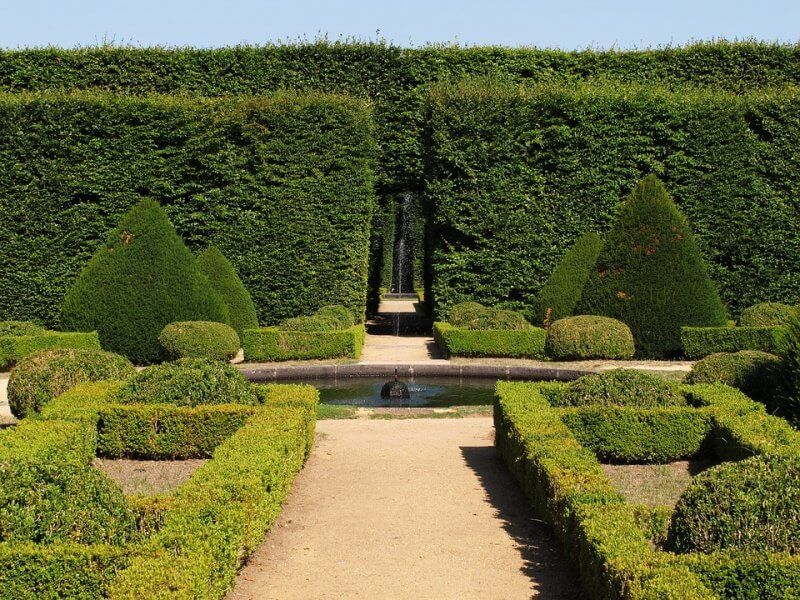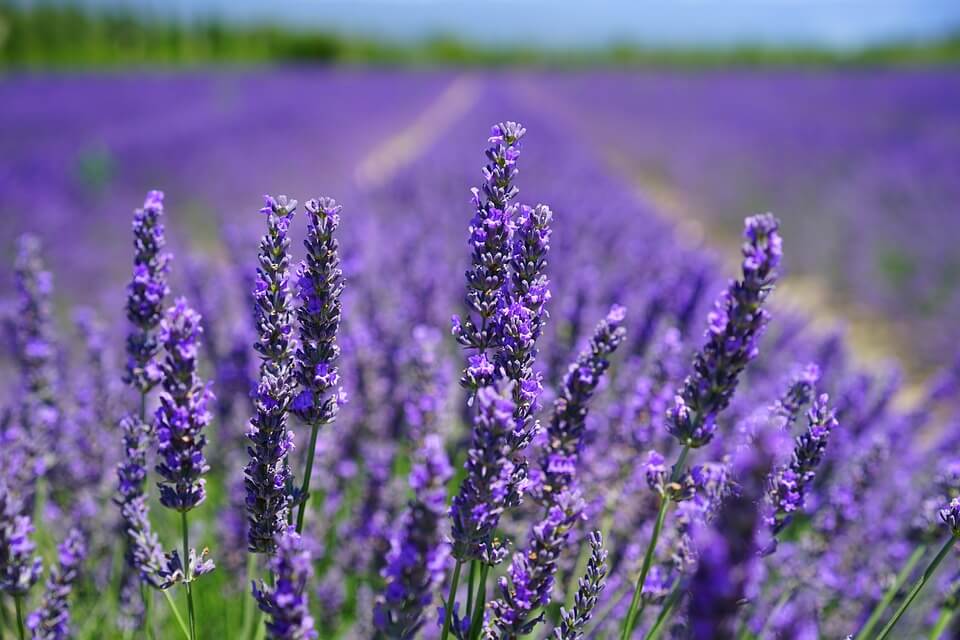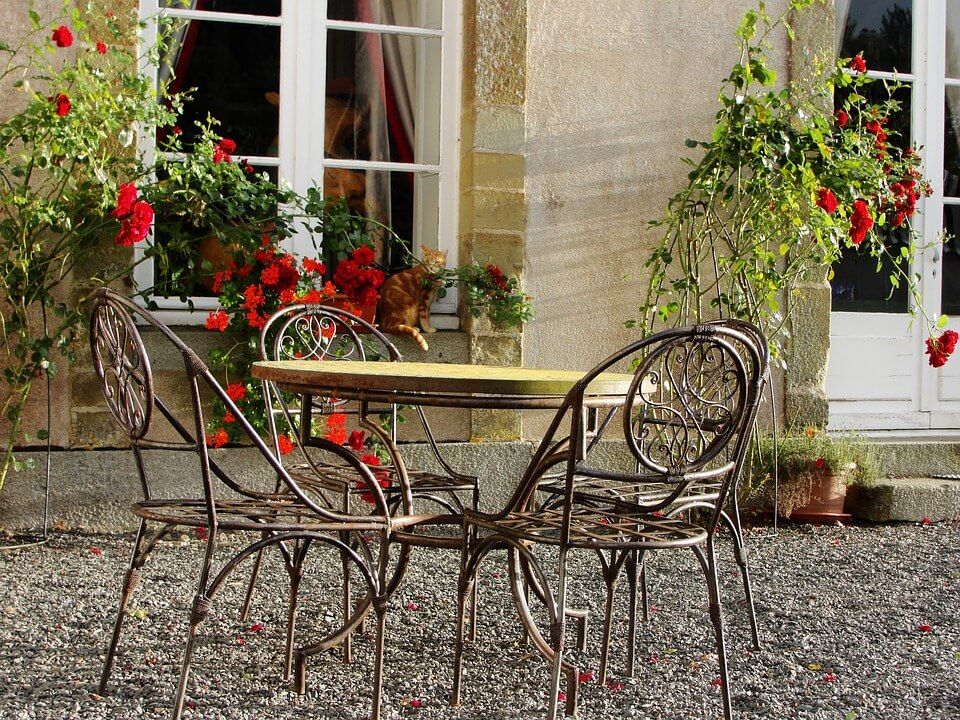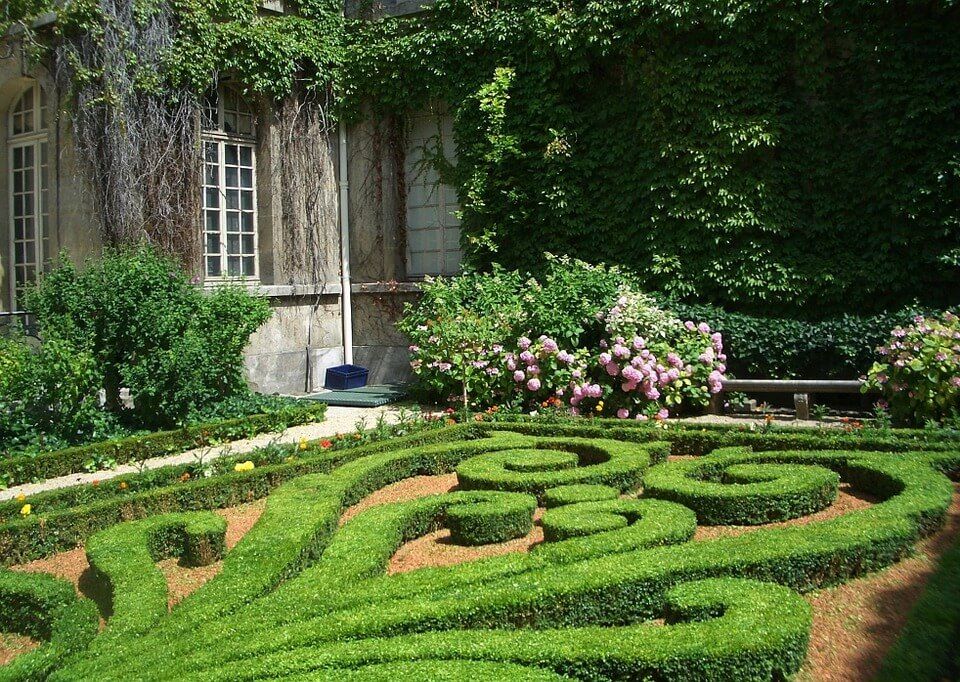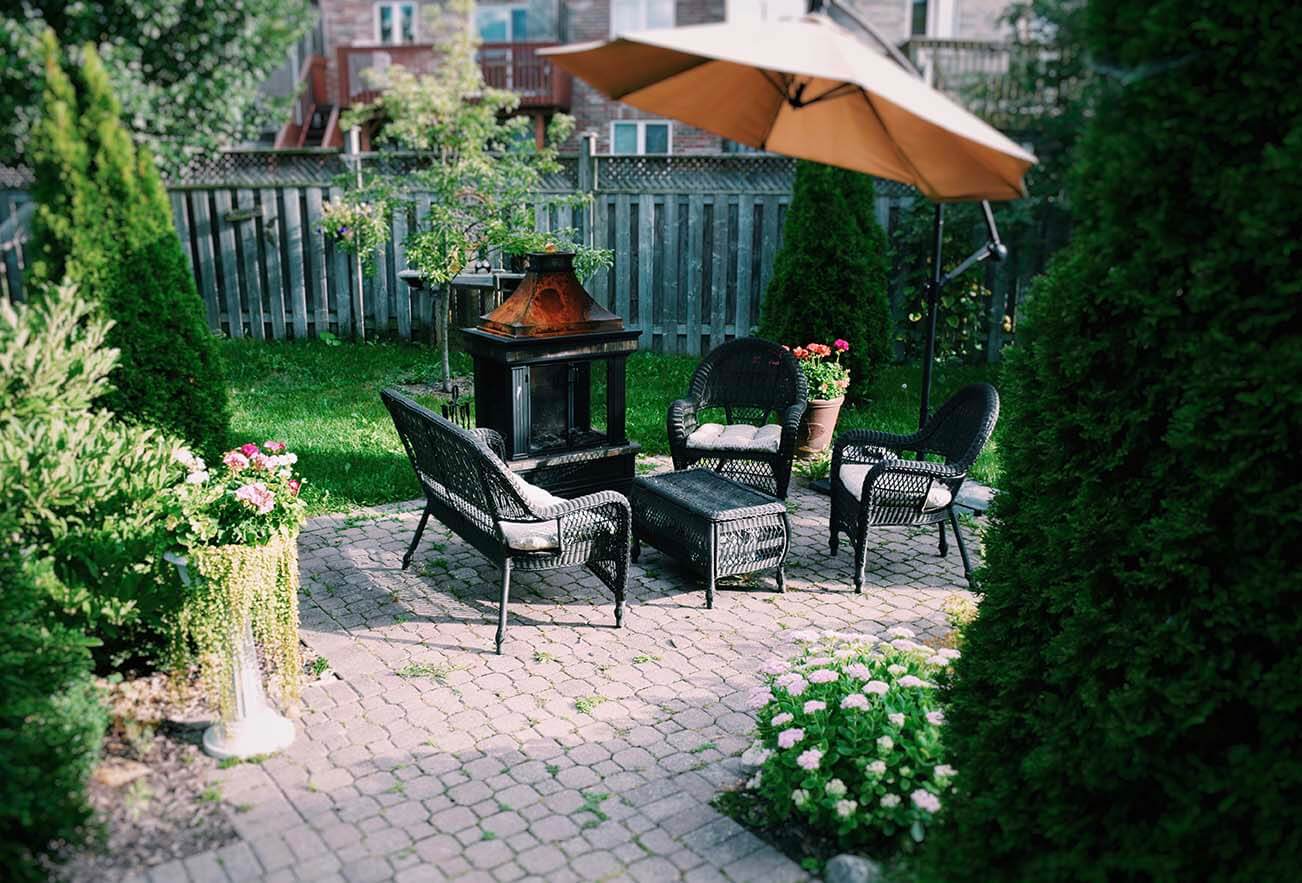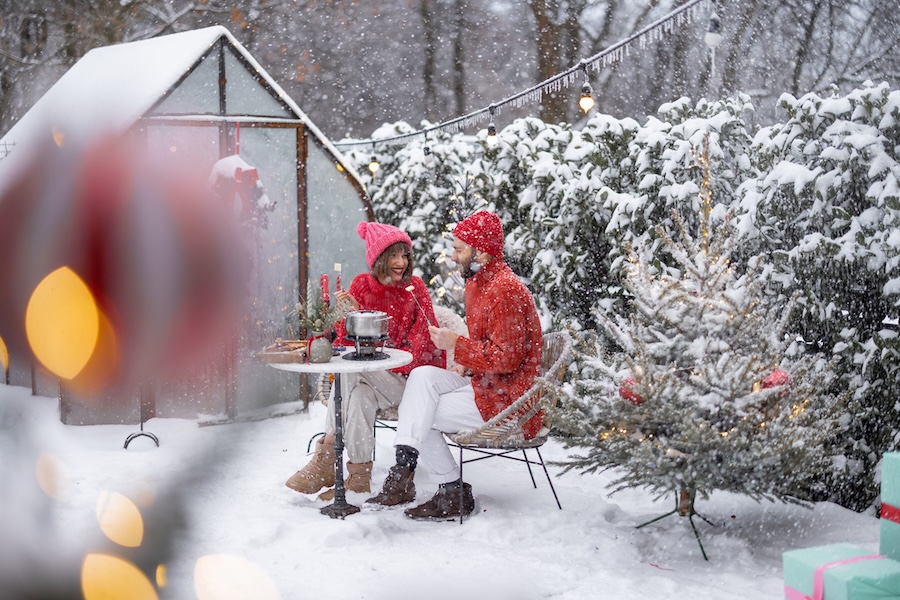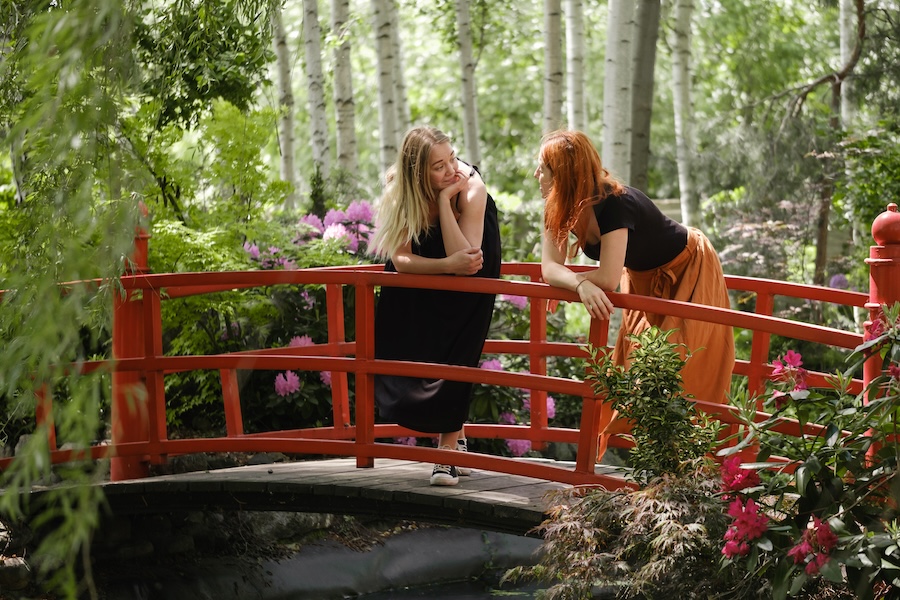French gardens embody a timeless elegance, characterized by their symmetry and classical design elements. Whether it’s the grandeur of traditional French gardens or the rustic charm of French country gardens, these landscapes offer a refreshing escape.
Here’s how you can bring this refined aesthetic to your own backyard.
Essential Elements of French Garden Design
Creating a French garden is about more than just planting a few flowers. It involves careful consideration of design elements that are steeped in centuries of tradition and aesthetic philosophy:
Symmetry and Structure in Garden Design
Symmetry is the soul of a French garden. It brings a sense of balance and formality that is both visually pleasing and deeply calming.
To incorporate symmetry in your garden design, start with a central axis. This could be a pathway, a row of hedges, or a water feature that serves as the backbone of your garden layout. Mirror image planting on either side of this axis ensures that each half of the garden reflects the other in perfect harmony.
Practical tips to achieve this include using geometric plant beds, symmetrical arrangements of furniture, and consistent use of materials throughout the space.
Color Palette: A Symphony of Cool Tones
The colour scheme in a French garden is typically subdued, relying heavily on greens and other cool tones such as whites, blues, and soft purples.
These colours not only complement the architectural elements of the garden but also help in creating a tranquil atmosphere. Lavender, with its soft purple hues and calming fragrance, is a staple in these gardens. To effectively use colour in your French garden, plan your blooms to ensure a continuity of colour throughout the seasons, providing a constantly evolving backdrop to the structural greens.
Stonework and Sculptural Elegance
Intricate stonework and strategically placed sculptures add a layer of sophistication and intrigue to French gardens. From ornate fountains to simple spherical stone sculptures, these elements serve as focal points that draw the eye and centralize the symmetry of the garden.
When choosing sculptures, opt for classic themes such as cherubs, animals, or mythological figures that blend with the natural environment. For stonework, consider paths and edgings that define and contain the planting areas while enhancing the overall aesthetic of the garden.
Designing Your French Garden: Practical Tips and Inspiration
Designing a French garden is like crafting a live painting, where each element has its place, and every detail counts:
Laying Out Your Garden: A Blueprint for Elegance
Designing a French garden requires careful planning. Begin by sketching out your design on paper, noting the placement of each element from plants to pathways.
Consider the viewing angles from inside your home and how the garden will look in each season. Keeping maintenance in mind is crucial; ensure that every element is accessible and practical to maintain.
Water Features: The Heartbeat of Tranquility
Water features, such as small ponds or ornate fountains, are essential in French gardens. They introduce sound and movement into the garden, enhancing the sensory experience.
Place your water feature centrally if possible, or use it to terminate the view along a main axis, providing a visual full stop that anchors the garden’s layout.
Cultivating Beauty: Plant Selection and Care
When it comes to cultivating the perfect French garden, choosing the right plants is as crucial as any design element.
Traditional French gardens often feature a variety of structured plantings that include both perennial borders and formal hedges. You’ll want to focus on plants that not only thrive in your local climate but also adhere to the color and textural themes typical of these gardens.
Boxwoods are a staple in French garden designs due to their dense, leafy nature which makes them ideal for creating sculpted hedges that line pathways or define garden rooms. Lavender, with its soothing scent and vibrant purple blooms, adds a splash of color and is quintessentially French. It’s perfect for bordering walkways or as part of a sensory garden where you can enjoy its aroma on warm, sunny days.
To infuse your garden with a variety of colors and textures throughout the year, consider integrating seasonal blooms.
Spring might see the bright yellows of forsythia, while summer could bring the lush pinks and reds of roses, and hydrangeas might grace your garden with their large blooms in varying shades of blue, pink, and white during the fall. The idea is to have a succession of colors and scents throughout the seasons, which not only keeps the garden visually interesting but also attracts a variety of wildlife.
Architectural Elements in French Gardens
Beyond plant life, the architectural elements you choose play a pivotal role in defining the character of your French garden. Together, the right plants and architectural features will bring a sense of order, elegance, and historical depth to your French garden, making it not only a pleasure to view but also a delight to traverse.
Pergolas and Arbors
These structures add vertical interest to your garden and provide support for climbing plants like roses and ivy. In smaller gardens, a single arbour can create a stunning focal point, while larger spaces can accommodate extensive pergola-covered walkways.
Pathways and Terraces: The Foundation of Garden Layout
Pathways should be both functional and aesthetic, guiding visitors through the garden while complementing its design.
Use materials like crushed stone or aged brick for a classic look. Terraces are perfect for creating outdoor living spaces, extending the usability of the garden for dining and relaxation.
French Garden Furniture and Decor
When you’re setting up a French garden, selecting the right furniture and decor isn’t just about filling space—it’s about continuing the elegance and charm that your plants and architectural elements begin. French garden furniture typically features classic designs that emphasize comfort and durability while fitting seamlessly into the garden’s aesthetic.
For your garden, consider choosing pieces made from wrought iron or weathered wood, which not only withstand the elements but also complement the natural beauty and refined structure of French garden designs.
Tables and chairs with intricate metalwork can evoke the sophistication of a Parisian café, providing a perfect spot for morning coffee or afternoon tea right in your backyard. When placing your furniture, think about how it interacts with the garden around it. Ideally, it should offer views of the garden’s highlights, like a beautifully sculpted hedge or a vibrant flowerbed, enhancing the experience of both relaxation and the garden’s visual appeal.
Decor extends beyond furniture to include urns, statues, and even bird baths that should reflect the garden’s theme.
Urns can be used to house plants or simply as standalone pieces that add to the garden’s classical feel. Statues should be chosen and placed thoughtfully to draw the eye and add narrative or artistic flair without overwhelming the space. Consider the scale carefully; too large could dominate, too small might get lost in the broader landscape.
Adapting the French Style to Small Spaces
You might think you need a vast estate to create a French garden, but even the smallest spaces can embody the elegance and order of this style with a few adaptations. For those with limited space, the key is focusing on vertical gardening techniques. Utilize wall-mounted planters or trellises to grow climbing plants like ivy or roses. This approach not only saves floor space but also adds lush, vertical greenery that is so characteristic of French landscapes.
Incorporating French design elements into balconies, patios, or small backyards involves miniaturizing traditional French elements to fit the scale of your space. For example, instead of large pathways lined with hedges, consider smaller, gravel paths bordered by low-growing lavender or boxwood. These create the structure and formality of a French garden without requiring extensive ground space.
Creating symmetry, an essential element of French gardens, can be achieved by arranging plants and decor to mirror each other across a central feature like a small fountain or sculpture. Even in a confined area, the careful placement of elements can create the illusion of space and structure that makes French gardens so appealing.
By creatively using furniture that doubles as decor and optimizing vertical space, even the coziest outdoor area can capture the spirit of a French garden. Remember, the goal is to create a space that feels both organized and inviting, allowing you to enjoy the beauty and tranquility of a French garden no matter the size of your green space.
Maintaining Your French Garden
Maintaining a French garden involves more than just regular watering and weeding; it’s about preserving the structure, elegance, and intricate details that define this style.
Regular Upkeep
Maintaining the elegance of a French garden requires regular care. Set a routine for pruning and trimming to preserve the garden’s formal appearance. Regularly check for and address any issues with pests or diseases, as these can quickly affect the symmetry and overall health of your garden.
Dealing with Pests and Weather Challenges
Creating a French garden outside of France means you might face gardening challenges unique to your local environment. Pests and weather conditions can significantly impact the health and appearance of your garden. To protect your outdoor oasis, start by choosing plants that are well-suited to your area’s climate. This reduces the need for extensive interventions to keep them healthy.
For gardens in areas prone to pests, consider incorporating plants that naturally repel insects or attract beneficial insects that will help keep pest populations under control.
For instance, lavender not only fits the aesthetic of a French garden but also repels mosquitoes and moths while attracting pollinators like bees.
Weather adaptation is also critical. In areas with heavy rainfall, ensure proper drainage to prevent water from pooling and damaging plants. This might include installing French drains or slightly elevating garden beds.
For gardens in hot, dry areas, choosing drought-resistant plants or implementing a xeriscape design can reduce water usage without sacrificing beauty.
Additionally, installing protective barriers can shield your garden from harsh weather. For example, using cold frames or cloches can protect delicate plants from frost, while shade cloths can prevent leaf burn during heatwaves. These adaptations not only help your garden survive but thrive, regardless of the local climate challenges.
Final Thoughts on Cultivating Your French-Inspired Garden
Creating a French garden is about more than just planting flowers; it’s about cultivating an atmosphere of peace and refinement. Whether your garden sprawls across a large estate or tucks neatly into a small urban space, the principles of French design can help you create a tranquil retreat from the busy world.
Embrace the structural formality, the subtle yet impactful use of colour, and the meticulous attention to detail that are hallmarks of French garden design. With careful planning and a commitment to maintaining these elements, your garden can serve as a personal sanctuary that embodies the timeless elegance and classic beauty of the French landscape aesthetic.
No matter the size of your space, the spirit of the French garden can make every corner of your outdoor area feel a bit more enchanted. And if you need help, Jonathan Robert Landscapes is just one click away.

In 2008, following a successful career as a member of the Canadian Alpine Ski Team, Jonathan Robert stepped into the landscaping industry, starting Jonathan Robert Landscapes. In the years since he’s quickly earned a reputation for high-quality work with creative designs and has been recognized in several industry-leading publications. Jonathan’s always got an eye on innovation and is always looking ahead to see what’s on the horizon in the industry. He works hard to stay on top of current guidelines, practices, and regulations. Jonathan is a member of Landscape Ontario, the International Concrete Paving Industry (ICPI), Canadian Nursery Landscape Association (CNLA), and is a Tech-Pro contractor.

